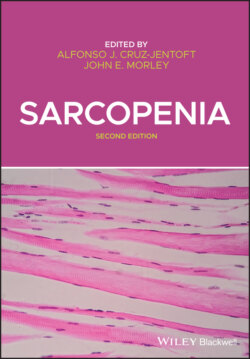Читать книгу Sarcopenia - Группа авторов - Страница 49
MECHANISMS OF MU REMODELING Role of resistance and endurance exercise in preserving MU function
ОглавлениеAnimal models have provided insights into the role of physical activity in maintaining the functioning of MUs. Older rats exposed to chronic exercise (10 months of swimming, 3 times/week) mitigated the loss of motor neurons, axon diameter, and fiber density in the gastrocnemius muscle when compared with sedentary age‐matched rats [36]. Another study in rats showed an 12.9% increase in fast fatigue‐resistant MUs after 8 weeks of endurance training (5 times/week of treadmill running) in the same muscle group as the previous study [37]. Of note, these MUs demonstrated faster twitch duration and increased ability to potentiate force after just 2 weeks of training [37]. Investigations involving spinal cord sections of aged mice revealed microglia content can be manipulated with endurance‐type exercise and prevent motor neuron loss [38]. However, how these findings translate to human neuromuscular physiology is unclear.
The only research elucidating the effects of age and exercise on the structure and function of MUs in humans has stemmed from masters athletes, who are typically described as individuals above 35 years old training and competing in intense athletic endeavors [39], although it is common to only include those aged over 60 years in this field of research. In a study from 2010 [40], the number of intact MUs in the tibialis anterior of masters runners (~65 years old) were compared with MU number (data published in 2005 [6]) in recreationally active controls (~25 years), and healthy age‐matched controls (~65 years) [40]. While MU number did not differ between the young and masters runners, there was a significant decline in the number of MUs in the old (~91 MU) compared with the masters runners (~140 MU) and younger (~150 MU) cohort [40], demonstrating a benefit of chronic exercise. However, these findings could not be repeated in a subsequent study, where the same anatomical muscle was examined for MU number using similar methods in healthy young (~ 26 years), master runners (~69 years), and older adults (71 years), and found both groups of old had fewer MUs than young, with no difference between older athletes and non‐athletes [19].
The most recent study on this subject differed from the previous two in that endurance (distance runners) and power (sprinters) trained masters athletes were included along with a larger muscle group, the vastus lateralis [18]. Again, there were no differences in the estimated number of MUs between healthy old and highly active masters athletes of either discipline. Comparisons showed MU potential size was greater in all older groups compared with young; however, this affect was augmented in both groups of masters athletes compared with the older controls. The authors suggested this benefit may be related to the ability of axonal sprouting and reinnervating of denervated fibers with advancing age [18], as previously described. This notion was further supported with recent biopsy data from older female masters athletes (~80 years) who demonstrated fewer markers of denervation and greater reinnervation capacity than age‐matched sedentary women (~77 years) [41].
While considering the dearth number of studies available, the abovementioned data suggest that regular endurance‐ or physical‐based exercise can offset some of the deleterious effects of aging on MU remodeling. Notwithstanding, further studies are needed to investigate the benefits of lifelong exercise in older adults, and particularly, the effect of exercise on rescuing MU structure and function in sarcopenic populations.
